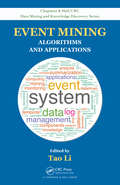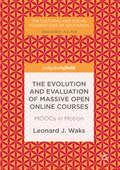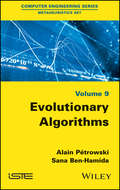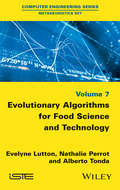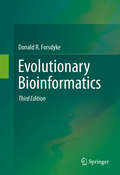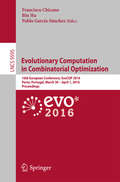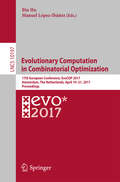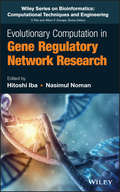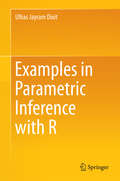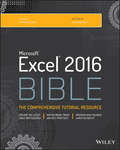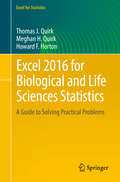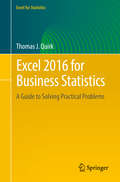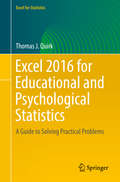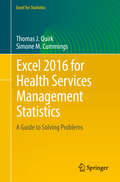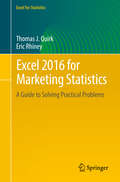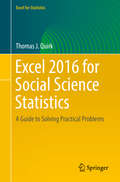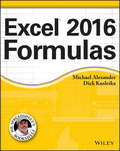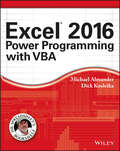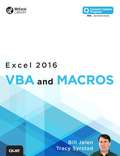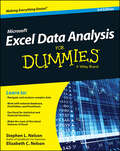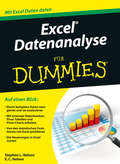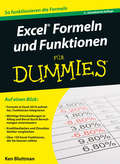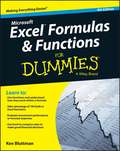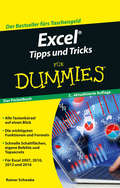- Table View
- List View
EVE: Valkyrie (Eve)
by Brian WoodSuperstar writer Brian Wood tells the origin of the Valkyrie--the deadliest spacefighter pilots in the EVE universe!This series leads into EVE Valkyrie, one of the most hotly anticipated video games of all time, a groundbreaking virtual reality space dogfighting shooter from the creators of EVE Online. With cloning technology that transmits them into a new body each time the old one dies in flames, the Valkyrie are immortal--the most skilled, most fearless pilots money can buy, mercenaries with loyalty to no one but each other.
Event Mining: Algorithms and Applications (Chapman & Hall/CRC Data Mining and Knowledge Discovery Series #38)
by Tao LiWith a focus on computing system management, this book presents a variety of event mining approaches for improving the quality and efficiency of IT service and system management. It covers different components in the data-driven framework, from system monitoring and event generation to pattern discovery and summarization. The book explores recent developments in event mining, such as new clustering-based approaches, as well as various applications of event mining, including social media.
The Evolution and Evaluation of Massive Open Online Courses
by Leonard J. WaksThis book offers a re-assessment of the educational and occupational value of MOOCs based on developments since 2013. When MOOCs appeared--amidst great fanfare--in 2012, leaders proclaimed an educational "revolution. " By 2013, however, dramatic failures, negative research findings, and sharp critiques ended the MOOC hype. This book examines both MOOCs and prior distance learning innovations, and offers a broad overview of their educational, economic and social effects. Chapters explore ties between MOOCs and emerging pedagogical models as well as exponentially rising tuition rates, student debt, and chronic underemployment of university graduates worldwide. It offers readers a comprehensive, up-to-the-moment guide to the MOOC phenomenon.
Evolutionary Algorithms
by Alain Petrowski Sana Ben-HamidaEvolutionary algorithms are bio-inspired algorithms based on Darwin’s theory of evolution. They are expected to provide non-optimal but good quality solutions to problems whose resolution is impracticable by exact methods. In six chapters, this book presents the essential knowledge required to efficiently implement evolutionary algorithms. Chapter 1 describes a generic evolutionary algorithm as well as the basic operators that compose it. Chapter 2 is devoted to the solving of continuous optimization problems, without constraint. Three leading approaches are described and compared on a set of test functions. Chapter 3 considers continuous optimization problems with constraints. Various approaches suitable for evolutionary methods are presented. Chapter 4 is related to combinatorial optimization. It provides a catalog of variation operators to deal with order-based problems. Chapter 5 introduces the basic notions required to understand the issue of multi-objective optimization and a variety of approaches for its application. Finally, Chapter 6 describes different approaches of genetic programming able to evolve computer programs in the context of machine learning.
Evolutionary Algorithms for Food Science and Technology
by Alberto Tonda Evelyne Lutton Nathalie PerrotResearchers and practitioners in food science and technology routinely face several challenges, related to sparseness and heterogeneity of data, as well as to the uncertainty in the measurements and the introduction of expert knowledge in the models. Evolutionary algorithms (EAs), stochastic optimization techniques loosely inspired by natural selection, can be effectively used to tackle these issues. In this book, we present a selection of case studies where EAs are adopted in real-world food applications, ranging from model learning to sensitivity analysis.
Evolutionary Bioinformatics
by Donald R. ForsdykeNow in its third edition and supplemented with more online material, this book aims to make the "new" information-based (rather than gene-based) bioinformatics intelligible both to the "bio" people and the "info" people. Books on bioinformatics have traditionally served gene-hunters, and biologists who wish to construct family trees showing tidy lines of descent. While dealing extensively with the exciting topics of gene discovery and database-searching, such books have hardly considered genomes as information channels through which multiple forms and levels of information have passed through the generations. This "new bioinformatics" contrasts with the "old" gene-based bioinformatics that so preoccupies previous texts. Forms of information that we are familiar with (mental, textual) are related to forms with which we are less familiar (hereditary). The book extends a line of evolutionary thought that leads from the nineteenth century (Darwin, Butler, Romanes, Bateson), through the twentieth (Goldschmidt, White), and into the twenty first (the final works of the late Stephen Jay Gould). Long an area of controversy, diverging views may now be reconciled.
Evolutionary Computation in Combinatorial Optimization
by Pablo García-Sánchez Bin Hu Francisco ChicanoThisbook constitutes the refereed proceedings of the 16th European Conference onEvolutionary Computation in Combinatorial Optimization, EvoCOP 2016, held in Porto,Portugal, in March/April 2016, co-located with the Evo*2015 events EuroGP,EvoMUSART and EvoApplications. The17 revised full papers presented were carefully reviewed and selected from 44submissions. The papers cover methodology, applications and theoretical studies. Themethods included evolutionary and memetic algorithms, variable neighborhoodsearch, particle swarm optimization, hyperheuristics, mat-heuristic and otheradaptive approaches. Applications included both traditional domains, such asgraph coloring, vehicle routing, the longest common subsequence problem, thequadratic assignment problem; and new(er) domains such as the traveling thiefproblem, web service location, and finding short addition chains. Thetheoretical studies involved fitness landscape analysis, local search and recombinationoperator analysis, and the big valley search space hypothesis. Theconsideration of multiple objectives, dynamic and noisy environments was alsopresent in a number of articles.
Evolutionary Computation in Combinatorial Optimization
by Bin Hu Manuel López-IbáñezThis book constitutes the refereed proceedings of the 16th European Conference on Evolutionary Computation in Combinatorial Optimization, EvoCOP 2016, held in Porto, Portugal, in March/April 2016, co-located with the Evo*2015 events EuroGP, EvoMUSART and EvoApplications. The 17 revised full papers presented were carefully reviewed and selected from 44 submissions. The papers cover methodology, applications and theoretical studies. The methods included evolutionary and memetic algorithms, variable neighborhood search, particle swarm optimization, hyperheuristics, mat-heuristic and other adaptive approaches. Applications included both traditional domains, such as graph coloring, vehicle routing, the longest common subsequence problem, the quadratic assignment problem; and new(er) domains such as the traveling thief problem, web service location, and finding short addition chains. The theoretical studies involved fitness landscape analysis, local search and recombination operator analysis, and the big valley search space hypothesis. The consideration of multiple objectives, dynamic and noisy environments was also present in a number of articles.
Evolutionary Computation in Gene Regulatory Network Research
by Nasimul Noman Hitoshi IbaIntroducing a handbook for gene regulatory network research using evolutionary computation, with applications for computer scientists, computational and system biologists This book is a step-by-step guideline for research in gene regulatory networks (GRN) using evolutionary computation (EC). The book is organized into four parts that deliver materials in a way equally attractive for a reader with training in computation or biology. Each of these sections, authored by well-known researchers and experienced practitioners, provides the relevant materials for the interested readers. The first part of this book contains an introductory background to the field. The second part presents the EC approaches for analysis and reconstruction of GRN from gene expression data. The third part of this book covers the contemporary advancements in the automatic construction of gene regulatory and reaction networks and gives direction and guidelines for future research. Finally, the last part of this book focuses on applications of GRNs with EC in other fields, such as design, engineering and robotics. * Provides a reference for current and future research in gene regulatory networks (GRN) using evolutionary computation (EC) * Covers sub-domains of GRN research using EC, such as expression profile analysis, reverse engineering, GRN evolution, applications * Contains useful contents for courses in gene regulatory networks, systems biology, computational biology, and synthetic biology * Delivers state-of-the-art research in genetic algorithms, genetic programming, and swarm intelligence Evolutionary Computation in Gene Regulatory Network Research is a reference for researchers and professionals in computer science, systems biology, and bioinformatics, as well as upper undergraduate, graduate, and postgraduate students. Hitoshi Iba is a Professor in the Department of Information and Communication Engineering, Graduate School of Information Science and Technology, at the University of Tokyo, Toyko, Japan. He is an Associate Editor of the IEEE Transactions on Evolutionary Computation and the journal of Genetic Programming and Evolvable Machines. Nasimul Noman is a lecturer in the School of Electrical Engineering and Computer Science at the University of Newcastle, NSW, Australia. From 2002 to 2012 he was a faculty member at the University of Dhaka, Bangladesh. Noman is an Editor of the BioMed Research International journal. His research interests include computational biology, synthetic biology, and bioinformatics.
Examples in Parametric Inference with R
by Ulhas Jayram DixitThis book discusses examples in parametric inference with R. Combining basic theory with modern approaches, it presents the latestdevelopments and trends in statistical inference for students who do not havean advanced mathematical and statistical background. The topics discussed inthe book are fundamental and common to many fields of statistical inference andthus serve as a point of departure for in-depth study. The book is divided intoeight chapters: Chapter 1 provides an overview of topics on sufficiency andcompleteness, while Chapter 2 briefly discusses unbiased estimation. Chapter 3focuses on the study of moments and maximum likelihood estimators, and Chapter 4presents bounds for the variance. In Chapter 5, topics on consistent estimatorare discussed. Chapter 6 discusses Bayes, while Chapter 7 studies some morepowerful tests. Lastly, Chapter 8 examines unbiased and other tests. Senior undergraduate and graduate students in statistics andmathematics, and those who have taken an introductory course in probability,will greatly benefit from this book. Students are expected to know matrixalgebra, calculus, probability and distribution theory before beginning thiscourse. Presenting a wealth of relevant solved and unsolved problems, the bookoffers an excellent tool for teachers and instructors who can assign homeworkproblems from the exercises, and students will find the solved examples hugelybeneficial in solving the exercise problems.
Excel 2016 Bible (Bible)
by John WalkenbachThe complete guide to Excel 2016, from Mr. Spreadsheet himself Whether you are just starting out or an Excel novice, the Excel 2016 Bible is your comprehensive, go-to guide for all your Excel 2016 needs. Whether you use Excel at work or at home, you will be guided through the powerful new features and capabilities by expert author and Excel Guru John Walkenbach to take full advantage of what the updated version offers. Learn to incorporate templates, implement formulas, create pivot tables, analyze data, and much more. Navigate this powerful tool for business, home management, technical work, and much more with the only resource you need, Excel 2016 Bible. Create functional spreadsheets that work Master formulas, formatting, pivot tables, and more Get acquainted with Excel 2016's new features and tools Customize downloadable templates and worksheets Whether you need a walkthrough tutorial or an easy-to-navigate desk reference, the Excel 2016 Bible has you covered with complete coverage and clear expert guidance.
Excel 2016 for Biological and Life Sciences Statistics
by Thomas J. Quirk Meghan H. Quirk Howard F. HortonThis book is a step-by-step exercise-driven guide for students and practitioners who need to master Excel to solve practical biological and life science problems. If understanding statistics isn't your strongest suit, you are not especially mathematically-inclined, or if you are wary of computers, this is the right book for you. Excel is an effective learning tool for quantitative analyses in biological and life sciences courses. Its powerful computational ability and graphical functions make learning statistics much easier than in years past. However, Excel 2016 for Biological and Life Sciences Statistics: A Guide to Solving Practical Problems is the first book to capitalize on these improvements by teaching students and managers how to apply Excel 2016 to statistical techniques necessary in their courses and work. Each chapter explains statistical formulas and directs the reader to use Excel commands to solve specific, easy-to-understand biological and life science problems. Practice problems are provided at the end of each chapter with their solutions in an appendix. Separately, there is a full Practice Test (with answers in an Appendix) that allows readers to test what they have learned.
Excel 2016 for Business Statistics
by Thomas J. QuirkThis book shows the capabilities of Microsoft Excel in teaching business statistics effectively. Similar to the previously published Excel 2010 for Business Statistics, this book is a step-by-step exercise-driven guide for students and practitioners who need to master Excel to solve practical business problems. If understanding statistics isn't your strongest suit, you are not especially mathematically-inclined, or if you are wary of computers, this is the right book for you. Excel, a widely available computer program for students and managers, is also an effective teaching and learning tool for quantitative analyses in business courses. Its powerful computational ability and graphical functions make learning statistics much easier than in years past. However, Excel 2016 for Business Statistics: A Guide to Solving Practical Problems is the first book to capitalize on these improvements by teaching students and managers how to apply Excel to statistical techniques necessary in their courses and work. Each chapter explains statistical formulas and directs the reader to use Excel commands to solve specific, easy-to-understand business problems. Practice problems are provided at the end of each chapter with their solutions in an appendix. Separately, there is a full Practice Test (with answers in an Appendix) that allows readers to test what they have learned.
Excel 2016 for Educational and Psychological Statistics: A Guide to Solving Practical Problems (Excel for Statistics)
by Thomas J QuirkThis book shows the capabilities of Microsoft Excel in teaching educational and psychological statistics effectively. Similar to the previously published Excel 2013 for Educational and Psychological Statistics, this book is a step-by-step exercise-driven guide for students and practitioners who need to master Excel to solve practical education and psychology problems. If understanding statistics isn’t your strongest suit, you are not especially mathematically-inclined, or if you are wary of computers, this is the right book for you.<P><P> Excel, a widely available computer program for students and managers, is also an effective teaching and learning tool for quantitative analyses in education and psychology courses. Its powerful computational ability and graphical functions make learning statistics much easier than in years past. However, Excel 2016 for Educational and Psychological Statistics: A Guide to Solving Practical Problems is the first book to capitalize on these improvements by teaching students and managers how to apply Excel to statistical techniques necessary in their courses and work.<P> Each chapter explains statistical formulas and directs the reader to use Excel commands to solve specific, easy-to-understand educational and psychological problems. Practice problems are provided at the end of each chapter with their solutions in an appendix. Separately, there is a full Practice Test (with answers in an Appendix) that allows readers to test what they have learned.
Excel 2016 for Health Services Management Statistics
by Thomas J. Quirk Simone M. CummingsThis book shows the capabilities of Microsoft Excel in teaching health services management statistics effectively. Similar to the previously published Excel 2013 for Health Services Management Statistics, this book is a step-by-step exercise-driven guide for students and practitioners who need to master Excel to solve practical health service management problems. If understanding statistics isn't your strongest suit, you are not especially mathematically-inclined, or if you are wary of computers, this is the right book for you. Excel, a widely available computer program for students and managers, is also an effective teaching and learning tool for quantitative analyses in health service courses. Its powerful computational ability and graphical functions make learning statistics much easier than in years past. However, Excel 2016 for Health Services Management Statistics: A Guide to Solving Practical Problems is the first book to capitalize on these improvements by teaching students and managers how to apply Excel to statistical techniques necessary in their courses and work. Each chapter explains statistical formulas and directs the reader to use Excel commands to solve specific, easy-to-understand health service management problems. Practice problems are provided at the end of each chapter with their solutions in an appendix. Separately, there is a full Practice Test (with answers in an Appendix) that allows readers to test what they have learned.
Excel 2016 for Marketing Statistics
by Thomas J. Quirk Eric RhineyThis is the first book to show the capabilities of Microsoft Excel in teaching marketing statistics effectively. It is a step-by-step exercise-driven guide for students and practitioners who need to master Excel to solve practical marketing problems. If understanding statistics isn't your strongest suit, you are not especially mathematically-inclined, or if you are wary of computers, this is the right book for you. Excel, a widely available computer program for students and managers, is also an effective teaching and learning tool for quantitative analyses in marketing courses. Its powerful computational ability and graphical functions make learning statistics much easier than in years past. However, Excel 2016 for Marketing Statistics: A Guide to Solving Practical Problems is the first book to capitalize on these improvements by teaching students and managers how to apply Excel to statistical techniques necessary in their courses and work. Each chapter explains statistical formulas and directs the reader to use Excel commands to solve specific, easy-to-understand marketing problems. Practice problems are provided at the end of each chapter with their solutions in an appendix. Separately, there is a full Practice Test (with answers in an Appendix) that allows readers to test what they have learned.
Excel 2016 for Social Science Statistics
by Thomas J QuirkThis book shows the capabilities of Microsoft Excel in teaching social science statistics effectively. Similar to the previously published Excel 2013 for Social Sciences Statistics, this book is a step-by-step exercise-driven guide for students and practitioners who need to master Excel to solve practical social science problems. If understanding statistics isn’t your strongest suit, you are not especially mathematically-inclined, or if you are wary of computers, this is the right book for you.<P><P> Excel, a widely available computer program for students and managers, is also an effective teaching and learning tool for quantitative analyses in social science courses. Its powerful computational ability and graphical functions make learning statistics much easier than in years past. However, Excel 2016 for Social Science Statistics: A Guide to Solving Practical Problems is the first book to capitalize on these improvements by teaching students and managers how to apply Excel to statistical techniques necessary in their courses and work.<P> Each chapter explains statistical formulas and directs the reader to use Excel commands to solve specific, easy-to-understand social science problems. Practice problems are provided at the end of each chapter with their solutions in an appendix. Separately, there is a full Practice Test (with answers in an Appendix) that allows readers to test what they have learned.
Excel 2016 Formulas (Mr. Spreadsheet's Bookshelf)
by Michael Alexander Richard KusleikaLeverage the full power of Excel formulas Excel 2016 Formulas is fully updated to cover all of the tips, tricks, and techniques you need to maximize the power of Excel 2016 through the use of formulas. This comprehensive book explains how to create financial formulas, release the power of array formulas, develop custom worksheet functions with VBA, debug formulas, and much more. Whether you're a beginner, a power user, or somewhere in between this is your essential go-to for the latest on Excel formulas. When conducting simple math or building highly complicated spreadsheets that require formulas up to the task, leveraging the right formula can heighten the accuracy and efficiency of your work, and can improve the speed with which you compile and analyze data. Understanding which formulas to use and knowing how to create a formula when you need to are essential. Access tips, tricks, and techniques that have been fully updated to reflect the latest capabilities of Microsoft Excel Create and use formulas that have the power to transform your Excel experience Leverage supplemental material online, including sample files, templates, and worksheets from the book
Excel 2016 Power Programming with VBA (Mr. Spreadsheet's Bookshelf)
by Michael Alexander Richard KusleikaMaximize your Excel experience with VBA Excel 2016 Power Programming with VBA is fully updated to cover all the latest tools and tricks of Excel 2016. Encompassing an analysis of Excel application development and a complete introduction to Visual Basic for Applications (VBA), this comprehensive book presents all of the techniques you need to develop both large and small Excel applications. Over 800 pages of tips, tricks, and best practices shed light on key topics, such as the Excel interface, file formats, enhanced interactivity with other Office applications, and improved collaboration features. In addition to the procedures, tips, and ideas that will expand your capabilities, this resource provides you with access to over 100 online example Excel workbooks and the Power Utility Pak, found on the Mr. Spreadsheet website. Understanding how to leverage VBA to improve your Excel programming skills can enhance the quality of deliverables that you produce—and can help you take your career to the next level. Explore fully updated content that offers comprehensive coverage through over 900 pages of tips, tricks, and techniques Leverage templates and worksheets that put your new knowledge in action, and reinforce the skills introduced in the text Access online resources, including the Power Utility Pak, that supplement the content Improve your capabilities regarding Excel programming with VBA, unlocking more of your potential in the office Excel 2016 Power Programming with VBA is a fundamental resource for intermediate to advanced users who want to polish their skills regarding spreadsheet applications using VBA.
Excel 2016 VBA and Macros
by Bill Jelen Tracy SyrstadUse this guide to automate virtually any routine task: save yourself hours, days, maybe even weeks! Make Excel do things you thought were impossible, discover macro techniques you won’t find anywhere else, and create automated reports that are amazingly powerful. Bill Jelen and Tracy Syrstad help you instantly visualize information, so you can act on it… capture data from anywhere, and use it anywhere… automate Excel 2016’s best new features. You’ll find simple, step-by-step instructions, real-world case studies, and 50 workbooks packed with bonus examples, macros, and solutions–straight from MrExcel!
Excel Data Analysis For Dummies
by Stephen L. NelsonWhat the book covers: The book focuses on the features of Excel that are important to businesses and researchers, including working with external databases, PivotTables and Pivot Charts, using Excel for statistical and financial functions, data sharing, working with Solver, using the Small Business Finance Manager, and more. Updated coverage of the new version: A technology update to the existing edition for Excel X. This new edition will have approximately 30% new content covering the latest updates and enhancements made to Microsoft Excel. Series features: Information presented in the straightforward but fun language that has defined the Dummies series.
Excel Datenanalyse für Dummies (Für Dummies)
by Stephen L. Nelson E. C. NelsonSie haben manchmal den Eindruck, Sie ertrinken in Daten? Kennen Sie schon die großartigen Datenanalysewerkzeuge von Excel? Stephen L. Nelson und Elizabeth C. Nelson zeigen Ihnen, wie Sie zu Ihren Daten PivotTables und PivotCharts erstellen, welche Excel-Funktionen zu Statistik und Finanzwesen es gibt und wie Sie Excel mit Daten aus externen Datenbanken nutzen. Erfahren Sie endlich, was all die vermeintlich todlangweiligen Zahlen wirklich zu bedeuten haben. Mit diesem Buch können Sie die Verarbeitung der Daten Excel überlassen und Ihre Zeit wieder für echte Einsichten und Entscheidungen nutzen.
Excel Formeln und Funktionen für Dummies: Bringen Sie Excel In Form, Damit Ihre Tabellen Funktionieren (Für Dummies)
by Ken BluttmanIn Excel 2016 gibt es mehr als 400 Funktionen, von ABRUNDEN bis ZZR. Aber welche der vielen Funktionen erleichtert Ihnen Ihre Arbeit? Wie setzen Sie die Funktionen richtig ein? Wie lautet die Syntax? Dieses Buch stellt Excel-Einsteigern die 150 nützlichsten Excel-Funktionen ausführlich vor. Der richtige Gebrauch wird anhand von Alltagsbeispielen deutlich. Hier sind nur drei: Löschen Sie überflüssige und unschöne Leerzeichen in Ihren Tabellen, analysieren Sie die Leistungsverteilung in einer Schulklasse (oder einem Verkaufsteam), vergleichen Sie Kredite mit unterschiedlichen Laufzeiten und ermitteln Sie mit ZZR die Anzahl der Zahlungsperioden bei einer vorgegebenen Rückzahlungsrate.
Excel Formulas & Functions For Dummies
by Ken BluttmanGrab these Excel formulas and functions to make your life easier! Are you intimidated by major financial choices, like which loan to get or how to grow your savings? Don′t worry we all are! But Excel Formulas & Functions For Dummies, 4th Edition can take some of the pain out of the data organization and analysis processes. This step-by-step reference sheds light on Microsoft Excel′s 150 most useful functions, and offers detailed instructions on how to implement them. Additionally, each function is illustrated by helpful, real-world examples that show how they are used within a larger formula. To take your knowledge of Excel′s functions a step further, 85 specialized functions are described in abbreviated form so you can use Excel to better support your decision-making process when securing a mortgage, buying a car, computing classroom grades, evaluating investment performance, and more. Functions are predefined formulas that you can use to make data analysis a bit easier within the Microsoft Excel framework. Functions use specific values, called arguments, to calculate a variety of things, from simple sums and averages to more complicated loan payments. Explore the 150 most useful functions that help Microsoft Excel make your life easier Access real-world examples of how functions fit into larger formulas Discover 85 specialized functions, which are described in abbreviated form and take your knowledge of Excel to the next level Understand how Microsoft Excel can help you make key decisions, such as whether to go with a 15-year or 30-year mortgage Excel Formulas & Functions For Dummies, 4th Edition brings order to chaotic data and helps you make decisions with confidence!
Excel Tipps und Tricks für Dummies (Für Dummies)
by Rainer W. SchwabeSie arbeiten bereits mit Excel und interessieren sich dafür, wie Sie Ihre Arbeitsabläufe schneller und effizienter gestalten können oder welche Möglichkeiten Ihnen Excel außerdem bietet? Rainer Schwabe erklärt Ihnen, wie Sie zum Beispiel die Benutzeroberfläche nach Ihren Wünschen gestalten, wie Sie Tastenkürzel erstellen, welche Entwicklertools besonders nützlich sind und mit welchen Tricks das alles noch viel schneller funktioniert.

